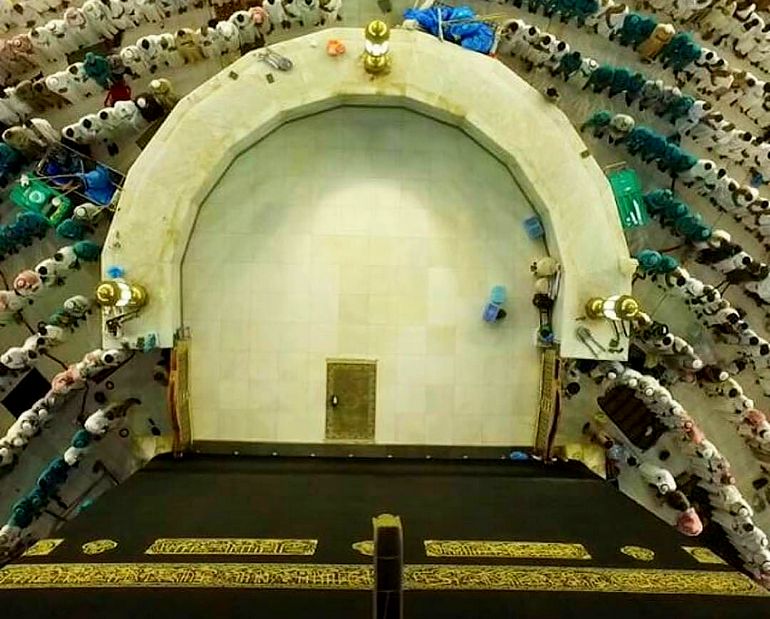http://www.islamiclandmarks.com/makkah-haram-sharief/hateem-hijr-ismail
The Hateem is the crescent shaped area immediately adjacent to the Ka’bah. Part of it is also known as the ‘Hijr Ismail’ as this was the place where Ebrahim (upon him be peace) constructed a shelter for Ismail (upon him be peace) and his mother Hajrah (upon her be peace).
- The grandfather of the Prophet (peace and blessings of Allah be on him), Abdul Muttalib, loved to be near the Ka’bah and he would sometimes order a couch to be spread for him in this space. One night, when he was sleeping there a shadowy figure came to him in a vision and instructed him where he would find the Zamzam well, which had laid buried from the time of the Jurhum tribe.
- When the Prophet (peace and blessings of Allah be on him) was 35 years old, a devastating flood damaged the Ka’bah and, as it had already been weakened by an earlier fire, was in danger of collapsing. Seeing that their house of worship was under threat, the Quraysh decided to rebuild the Ka’bah. They resolved not to taint the project with resources gained through usury (interest), prostitution or thieving. They came to know of a Roman ship that had become wrecked at a nearby port and a contingent went to purchase the wood of the ship. They also contracted a carpenter, named Baqoom, who had been one of the passengers on the ship to come and reconstruct the walls. The construction started with each tribe being allocated specific duties. The nobles among them carried pieces of stone and piled them up in one place. The Prophet (peace and blessings of Allah be on him) and his uncle Abbas were among those carrying stones. However, the tribes were unable to collect enough money to rebuilt the Ka’bah completely so a small wall was built showing the boundaries of the original foundation laid by Ebrahim (upon him be peace). This small wall enclosed an area on the northern side of the Ka’bah.
- Some scholars have mentioned that the graves of Ismail (upon him be peace) and his mother Hajra (upon her be peace) lie buried beneath the Hijr Ismail. However, others have dismissed the narrations as being Da’eef (weak).

Aerial view of the Hateem
- Aisha (may Allah be pleased with her) reports that when she asked the Prophet (peace and blessings of Allah be on him) whether the Hateem was part of the Ka’bah, he replied that it was. When she further asked why it was then not included in the walls of the Ka’bah, the Prophet (peace and blessings of Allah be on him) replied, “Because your people (the Quraysh) did not have sufficient funds.” [Bukhari]
- Aisha (may Allah be pleased with her) says, “When I expressed the wish to perform salah within the Ka’bah, the Prophet (peace and blessings of Allah be on him) took me by the hand and led me into the Hijr (Hateem) where he said, ‘Perform salah here if you wish to enter the Ka’bah because this is part of the Baytullah.’”
- It must be noted here that an area of approximately 3 meters adjacent to the wall on the side of the Hateem actually constitutes as being part of the Ka’bah, the rest falls outside the Ka’bah. It is however clear that Tawaf must be performed outside the complete area of the Hateem.
- Another narration states that Rasulullah (peace and blessings of Allah be on him) said, “O Aisha! Had your people not very recently been in the Period of Ignorance, I would have had the Ka’bah demolished and included the left-out portion within its walls. I would have also brought the inside of the Ka’bah to ground level and added two doors, with one on the eastern wall and the other on the western wall. In this manner, it would be according to the building and foundation of Ebrahim (upon him be peace).” In the year 65 AH, Abdullah bin Zubair (may Allah be pleased with him had the Ka’bah constructed according to this wish of the Prophet (peace and blessings of Allah be on him).
- There is a water outlet that channels water from the roof of the Ka’bah down to the Hateem area. This was first constructed by the Quraysh and is known as the ‘Meezab-e-Rahmah’ (the water outlet of mercy).
No comments:
Post a Comment